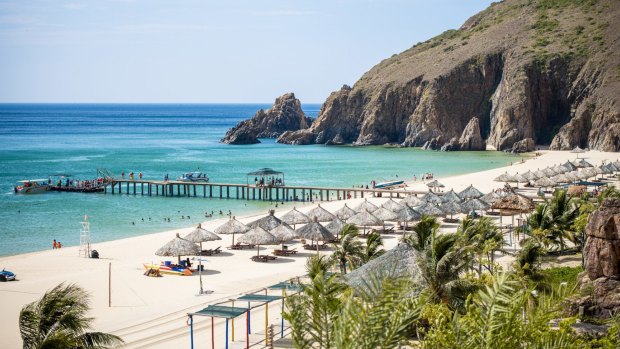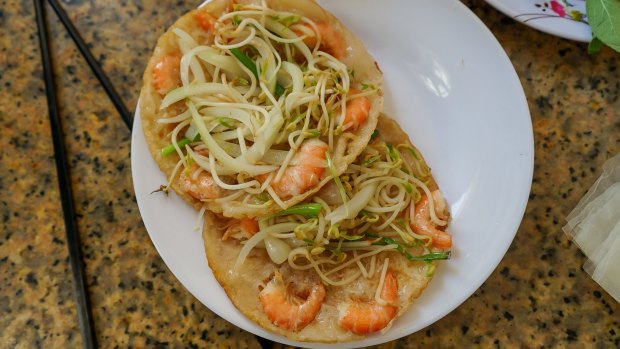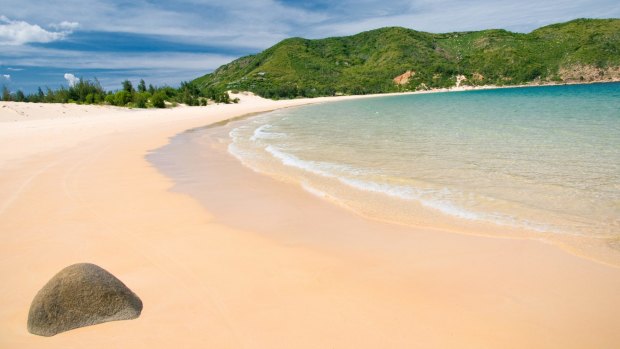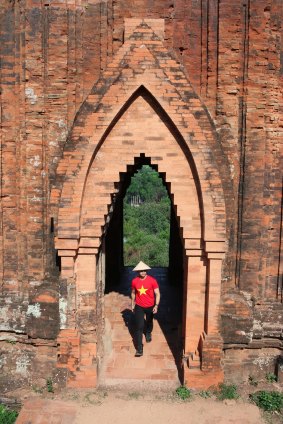This was published 2 years ago
Quy Nhon: Why you need to visit Vietnam's next big beach destination now

Blindingly white Ky Co beach, which an indeterminate person once called "Vietnam's Maldives".Credit: Nguyen Trong Nhan/iStock
In Vietnam, the difference between laying on an uncrowded beach where foreign tourists are still an anomaly, and sharing sand with gold-chained, pot-bellied Russian blokes in ill-fitting G-strings can be measured in kilometres.
Two-hundred, in fact, the distance between Vietnam's 'next big' beach destination, Quy Nhon, and Nha Trang, a former seaside secret that long ago traded its authentic-slice-of-small-town-Vietnam vibe for the big dong/dollars of generic, overdeveloped tourist-trap-ism.
The parallels between Central Coast sisters Quy Nhon (pronounced kwee nyawn) and pre-boom Nha Trang are much-discussed. Whether it likes it or not, the 'hidden gem' aspirant has arrived at the mass-tourism crossroads, because it perfectly embodies the travel cliché: both relatively hidden from foreign tourism (so far) and gem-like because it's stacked with all the elements needed for beach-holiday greatness.

Xuan Dieu (Seafood Street) is stacked with family-run restaurants serving scrummy banh xeo tom nhay ('jumping shrimp pancake).Credit: iStock
How can Quy Nhon still be a 'hidden gem' in such a compact and well-trodden place like Vietnam? Two reasons. First, this beautiful, bountiful country is awash with myriad compelling big-name destinations, from Hoi An on the coast to Sa Pa in the hills, which soak up travellers' attention. Second, Quy Nhon suffers/benefits from a relative tyranny of distance; not yet serviced by international flights (more on that later).
"Before resorts opened here [in 2016], Quy Nhon was just a rest-stop between Da Nang and Nha Trang," says Dinh Quoc Thich, owner of Quy Nhon Private Tours. "Even Vietnamese people used to ask where it was.
"I returned to Quy Nhon from Da Nang five years ago, even though there were no tourists yet, because resorts like [Vietnamese-owned] FLC began promoting it and many local tourists started coming."

The relatively laid-back city is fronted by seven tidy kilometres of beachfront.Credit: iStock
The relatively low-rise, laid-back city (population 457,000) is fronted by seven tidy kilometres of beachfront, hosting a couple of low-key beach bars, Surf 1 and Surf 2. Unlike Nha Trang, there's no 'tourist price' to speak of and you won't hear that grating beach-hawkers' refrain: "Hey mister, how much do you want to pay?"
One street back, Xuan Dieu (Seafood Street) is stacked with family-run restaurants serving scrummy banh xeo tom nhay ('jumping shrimp pancake) at prices that local workers (in the timber, clothing, mining, and rice- and fruit-farming industries) can afford.
Unlike South East Asia's usual 'themed' tourist streets, the scores of cafes along Do Doc Bao (Coffee Street) cater principally to the local taste for strong Vietnamese coffee, with Starbucks-clones slowly, inevitably dripping into the mix.

You'll discover a scattering of 700-year-old Champa towers in this now-Buddhist realm. Credit: Getty
Greater Binh Dinh province rewards the adventurous vacationer. Hop onto a rental scooter to explore idyllic beach-havens galore to the city's north and south – like solo-traveller sanctum Bai Xep Beach – and a scattering of 700-year-old Champa towers; ornate orange-bricked relics of Hinduism in this now-Buddhist realm.
Quy Nhon Private Tours can show you a trifecta of traditional artisan villages, around 30 kilometres outside town. Families in Phu Gia village make stunning conical hats – Non La (leaf hat) and Non Ngua (horse hat) – the latter crowned with materials that traditionally showed one's community position (bronze, gold). Van Son village specialises in ceramics while Cu Lam village distils the potent and popular Bau Da rice wine (45-per-cent alcohol).
Hotels have mushroomed in the city recently, including FLC City Hotel Quy Nhon Beach – which has a Singapore-by-the-beach swagger – and Pullman Condotel, which sticks up like a blingy sore thumb and casts a late-afternoon shadow over the beach bars.
Most foreign visitors, however, stay at one of five coastal resorts outside the city-limits, including super-luxe Anantara (15 kilometres south) and the one that started it all back in 2016, the FLC Quy Nhon Beach & Golf Resort.
Its 325-rooms, villas and "championship golf course" treads a 1500-hectare footprint onto formerly undeveloped beachfront, 20 kilometres north of the city. FLC has all the big-resort trimmings: a claimed "kilometre of pool to be swum", a nice mix of beach bars and restaurants, and requisite water activities including jet-skiing and snorkelling/diving on a nearby reef. There's even a purpose-built Zoo Safari Park.
The resort's four interconnecting white buildings (with a rollercoaster-track-like roof line) architecturally dominate neighbouring fishing village, Nhon Ly. However, resort General Manager, Ryszard Majewski, says a symbiotic relationship has developed between the two.
"Half of our 900 staff are local including at management level," he says. "And locals have opened [resort-related] businesses too because they see potential. Our guests go to the village to eat and spend money so the economy is really growing."
Outwardly, Nhon Ly seems unaffected by tourism so far. Early-risers can watch fishermen drag in their hauls off small basket boats, then catch frantic Vietnamese-style bargaining at fish markets that pack up soon after dawn. FLC arranges nighttime excursions on squid-fishing boats, too, where you can cook what you catch onboard.
Blindingly white Ky Co beach, which an indeterminate person once called "Vietnam's Maldives", lies a few kilometres south of FLC. From the incoming tour boat, the sand and water indeed exude a Maldivian palette, but the on-shore reality is an overcrowded Cirque du Tourism.
Parasailing boats at full-throttle compete with doof-doof barking from a chaotic restaurant neighboured by a live seal show. Queues of faux-designer-frocked, floppy-hatted day-trippers queue on the jetty to pose on designated Instagram-props that include a string-less white grand piano.
Ky Co Beach may be the exception, but is it a glimpse into Quy Nhon's future? Judging by the mass of pegged-out land developments alongside the beautiful drive from the city to FLC, the locals are expecting much more than just local tourism soon.
While Phu Cat airport (30 kilometres from the city) only has domestic connections from Hanoi and Ho Chi Minh right now, direct international flights from Korea are due to begin in late 2022. More international connections are rumoured to follow, with Australian capitals in that mix.
Located on one of the world's busiest shipping channels – the South China Sea or East Sea as the Vietnamese call it – and in a region with no hard-waste recycling infrastructure, Quy Nhon's environmental challenges are already floating to the surface, especially after a storm.
"I'm a swimmer so this rubbish sometimes frustrates me," says Majewski. "My plan is to open a water-bottling plant to go plastic-free [currently up to 2000 guests plus staff use bottled water daily]. And every month we'll get staff members to help clean up the beach."
Will Quy Nhon become a glorified FIFO swimming spot like Nha Trang? While I/we pine for untouched slices of paradise-found, the answer to that question lies firmly at the feet of the people and authorities here, who justifiably want their piece of a swelling post-Covid international-tourism pie.
Right now, Quy Nhon feels like a city comfortable in its own skin, a place that appreciates and takes care of its natural beauty and UNESCO sites. If I could tell its people one thing, it would be this: leave the zoos, jet-skis and other bombast for Nha Trang and the like. Even if you don't build it, we will come.
THE DETAILS
FLY
Bamboo Airways flies from Sydney to Ho Chi Minh, and Melbourne to Hanoi and Ho Chi Minh. Currently there is no extra charge for the one-stop connection from either city to Phu Cat Airport. See: www.bambooairways.com/au-en/
STAY
Prices to stay at the FLC Grand Hotel Quy Nhon start at $150 per night, including transfer from Phu Cat Airport (35 kilometres away). https://flchotelsresorts.com/en
TOUR
Quy Nhon Private Tours offers village, street food and cultural tours. See https://quynhonprivatetours.com/
MORE
Best time to visit Quy Nhon is April-September. Avoid typhoon season: October-November.
https://www.traveller.com.au/vietnam
The writer travelled as a guest of Bamboo Airways
Sign up for the Traveller Deals newsletter
Get exclusive travel deals delivered straight to your inbox. Sign up now.